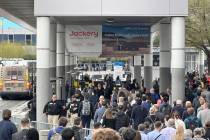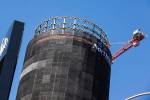New OSHA rule requiring more violations ruffles feathers
The state of Nevada plans to crack down on unsafe conditions at construction sites and other workplaces, but local builders say the effort isn't needed and will result in unwarranted citations written to meet quotas.
The Nevada Occupational Safety and Health Administration now requires its 41 investigators to find serious, willful repeat violations on at least half of their inspections. Before Friday's change, state inspectors were averaging 22 percent on finding serious, willful repeat violations.
The nationwide OSHA average for inspections resulting in that level of violation is 79 percent.
"The feds told us, 'You guys need to improve your game,' " said Steve Coffield, chief administrative officer of Nevada OSHA. "They're not saying we have to go out and find serious citations at every place we go because we're not going to. But they are saying that our performance basically has to work toward being as effective as federal OSHA's."
That explanation doesn't satisfy some local contractors, who say the rule amounts to a quota that will prompt inspectors to hunt for major violations that don't exist.
"It's like telling policemen they have to write more tickets. They'll stop you in a 55 mph zone and say you were going 56," said Bob Potter, president and chief executive officer of Affordable Concepts, a Las Vegas construction company that builds schools, banks, medical offices and restaurants. "It's important for contractors to maintain an exemplary safety record, but under this new guideline, I can assure you it will be impossible."
The new policy comes from a 2009 U.S. Department of Labor investigation into Nevada OSHA following a rash of workplace deaths from 2004 to 2009. High-profile fatalities included six construction workers at CityCenter, two at Cosmopolitan and two maintenance workers at The Orleans. From January 2008 to June 2009 alone, 25 Nevadans died on the job.
In an 80-page report on its findings, the Department of Labor criticized Nevada OSHA for failing to cite serious, willful repeat violations of safety laws and for failing to determine if companies ever fixed hazards noted in previous citations. The report added that Nevada OSHA's inspectors showed limited understanding of construction-safety hazards.
Coffield, who took the chief administrator job in September 2009, a month before the feds released their report, said it's not clear why state inspectors averaged 22 percent on finding serious, willful repeat violations. It could be because inspectors saw serious problems and intentionally ignored them, or because inspectors weren't trained well enough to spot on-the-job dangers.
The federal report's 18 recommendations included more training programs.
Nevada OSHA is also bringing on three staff trainers to meet the requirement, and will add four inspectors, boosting its ranks by nearly 10 percent, to 45, later this year. At the peak of the state's building boom, from 2006 to 2007, it had 38 inspectors.
Potter and other builders said the hiring "flies in the face of logic."
The agency will increase its investigative activities in the midst of a recession that wiped out nearly 100,000 construction jobs in the state, Potter notes. In mid-2006, Nevada had 148,800 construction workers, with one OSHA inspector for every 3,916 workers. Construction employment in the state has fallen to 54,700, and by fall, OSHA will have one inspector per 1,216 laborers.
"It's kind of like going and fixing the gate on the corral after all of the horses have left," Potter said. "They're absolutely right -- there were some significant violations on CityCenter. But they're taking the entire construction industry to task because of the violations of one general contractor. It's not fair at all.
"If you hire many more inspectors than you had before, and create an atmosphere where they're required to write more citations, you're going to develop a situation where the bulk of citations are going to be meritless," he added.
Nor do officials with the Las Vegas chapter of the trade group Associated General Contractors believe the new violations policy is necessary.
"We would agree it's not needed. We think that the majority of Southern Nevada contractors are incredibly safe," said Mandi Lindsay, the association's government affairs director. "What happened with CityCenter was an anomaly. We were in record growth with respect to building at that time. The reality is, there are only a few bad seeds out there. They should concentrate on those (companies), as opposed to a mass effort of looking at everyone."
But it doesn't matter how much construction and business activity has dropped in Nevada, Coffield said. The federal government still requires inspectors to find more violations. He added that Nevada OSHA offers a free consulting service through which businesses can invite inspectors to job sites to point out hazards. The agency won't cite companies for violations found during voluntary consultations.
He also said there are no performance incentives to meet the quota, or punishments for failing to meet it. Inspectors who miss the mark just get more training.
"Besides, if you're following the rules, and OSHA comes to visit you, you're not going to have a problem," Coffield said.
Contact reporter Jennifer Robison at jrobison@reviewjournal.com or 702-380-4512.























